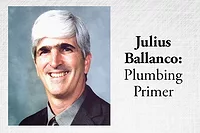What's All the Fuss About Faucets
There have been plenty of articles written about NSF 61. Heck, I’ve written a few articles myself! But it wasn’t until this deadline approached that everyone started asking, “How will this impact me as a contractor?” I have been reading the same articles, and no one seems to be answering that all important question, “What about me?” So, let me try to clarify that all important question.
First, a little background information. NSF 61 only applies to faucets that supply drinking water, not potable water. There are a lot of potable water applications that are not intended for drinking water. You shower and bathe with potable water, but aren’t supposed to be drinking the water from a shower valve or tub filler. NSF 61 specifically excludes shower valves and tub filler valves. It also does not apply to service sink faucets, sillcocks and commercial kitchen faucets. None of these faucets are intended to supply drinking water.
The faucets that are regulated by NSF 61 include kitchen faucets, lavatory faucets and drinking water dispensers. If a lavatory faucet was installed in a commercial toilet room, it would not be considered a faucet supplying drinking water. However, from a manufacturer’s standpoint, they don’t know if a lavatory faucet is being installed in a residential bathroom or a commercial toilet room. Therefore, they are required to have all lavatory faucets comply. As a contractor, you know where the faucet is installed. Hence, you are not required to have a faucet complying with NSF 61 for commercial toilet rooms. While this is a minor point, it is still good to know so that you understand the implications of the standard.
Third-Party Certification: Manufacturers are required to have their faucets certified by a third party agency. This is being done by testing labs such as NSF International and Underwriters Laboratories (UL).
If a faucet is not certified, it doesn’t mean that the faucet is not good. The certification process is a long and grueling process for manufacturers. The manufacturers have not stopped making faucets while they go through the certification process. In many cases, the uncertified faucets are identical to the certified faucets.
Some manufacturers, however, have had to completely modify their manufacturing process. The newer faucets either have a different brass, or they may go through a finishing rinse process.
Faucets that do not pass the certification process are not necessarily bad. The requirements in NSF 61 are very stringent. You would need some of the lousiest water in the country before the contaminant level became serious. For non-aggressive waters, the contaminants are not going to be detrimental. Additionally, the standard is based on drinking the first draw of water after the faucet sits for 10–12 hours. If you turn on a faucet and don’t catch the first few ounces of water, you just lost the contaminants that the faucet contributed to the drinking water.
Some of you may be saying that this is crazy. Well, it may sound crazy, but this is the way standards are being developed for the plumbing industry. They assume the worst case condition, even if you think such a condition is absurd.
For a faucet, the standard evaluated the first draw of a faucet being used to produce baby’s formula. This means that the contaminant levels are very low because babies have the lowest tolerance level for drinking water contaminants. The major contaminant, lead, also impacts small children the most, especially babies.
Them, Not You: So, who does the deadline affect? The manufacturers, not you.
The Environmental Protection Agency is concerned with the guys making the faucets, not the contractor out there trying to make a buck. If you have a bunch of faucets on your trucks or in the shop, the EPA is not going to come after you. Sure, you sell these faucets to your customers, but you first had to buy them yourself. The EPA is concerned with the manufacturer selling the faucets to the wholesale and retail outlets. Not you!
From the EPA’s perspective, as a contractor, you are a small fish in a big pond. They only want the big guys — the manufacturers. And, they don’t even want them. All they would like to see is that the manufacturers are producing products to the standard. As one friend working for the EPA said, “We’re not out to get anybody.”
The next question contractors have been asking me is, “Well, can my customer sue me if I install a faucet that does not comply with NSF 61 after the deadline?” As every attorney will tell you, your customer can sue you for anything. The key is to win in court.
If someone tries to hang their hat on the new federal requirements, they have a tough battle in court. It wouldn’t be worth the effort. For one thing, they would have to prove that the faucet you installed contaminates the water in an adverse manner. This would require some expensive testing. Furthermore, if we want to get real technical, every time someone sells a house, they could be selling, along with that house, a faucet that does not comply with NSF 61.
So sit back and relax. Don’t worry about this one. Let the manufacturers get all worked up.
Looking for a reprint of this article?
From high-res PDFs to custom plaques, order your copy today!







